
FEMALE URINARY INCONTINENCE
Urinary incontinence is the accidental release of urine and it is twice as common in women as in men. It is common for the bladder and sphincter muscles to weaken with age and especially if a woman has been through childbirth and menopause. At Blue Ridge Urological, our expert providers are highly experienced in diagnosing and treating female incontinence. This condition can affect more than one in three adult women, but it is treatable.
TYPES OF URINARY INCONTINENCE:
There are three main types of urinary incontinence that women can experience with stress incontinence being the most common type. Types of female incontinence include:
While urinary incontinence can occur at any age, women over the age of 50 are more likely to experience an accidental urine leakage.
CAUSES OF FEMALE URINARY INCONTINENCE
The main cause of urinary incontinence in women is muscle weakness in the pelvic floor and the muscles that control the bladder and sphincter. Pregnancy can cause the pelvic floor muscles to stretch and become weaker. When this happens, there may be inadequate support for the bladder causing it to sag or drop. Other causes of urinary incontinence include certain medications used to treat chronic health problems like high blood pressure, urinary tract infections and hormonal changes brought on by menopause. There are certain risk factors that increase the likelihood of developing female incontinence and they include:
SYMPTOMS OF FEMALE URINARY INCONTINENCE
The main symptom of female incontinence is the involuntary leakage of urine. Stress incontinence is the most common type of urinary leakage in women and may occur when the bladder is placed under stress as with laughing, coughing, sneezing or exercising.
Some additional symptoms of urinary incontinence are:
DIAGNOSING AND TREATING FEMALE URINARY INCONTINENCE
At Blue Ridge Urological, we understand that female incontinence is often an embarrassing medical condition that can impact the quality of life for many people. Some women may avoid certain activities and limit social events to minimize embarrassing situations. Our providers are board certified urologists who are compassionate and highly trained in treating female urinary incontinence. Blue Ridge Urological offers both surgical and nonsurgical treatment options for addressing stress incontinence issues.
If you are experiencing symptoms of urinary incontinence, it is important to consult a urologist to determine the root cause of leaking urine. Your doctor will perform a complete examination which will include medical history, physical exam, urinalysis, cough stress tests and possibly a cystoscopy. Your doctor may also want to perform bladder studies or urodynamic testing to determine how well the muscles of your bladder and sphincter are working.
Depending on how frequently you experience urinary incontinence, your doctor may recommend some nonsurgical options for treating stress incontinence. Some non-surgical treatment approaches include:
If the nonsurgical approach to urinary incontinence is not effective, there are other procedures that may help to reduce or prevent leakage. Bladder BOTOX® is usually the next step in treating patients who have tried behavioral therapy, medications and pelvic floor rehabilitation. The goal of Bladder BOTOX® therapy is to decrease urinary incontinence and frequency and relieve bladder spasms to restore quality of life for men and women who suffer from overactive bladder or urinary incontinence.
A surgical procedure known as the midurethral synthetic sling or sling procedure can be performed to provide support for stress incontinence. If you are suffering from urinary incontinence, Blue Ridge Urological offers a variety of treatment options in a caring and compassionate environment. Schedule your appointment today at (540) 932-5926.

